Makita HP2051F, HP2050, HP2050F User Manual
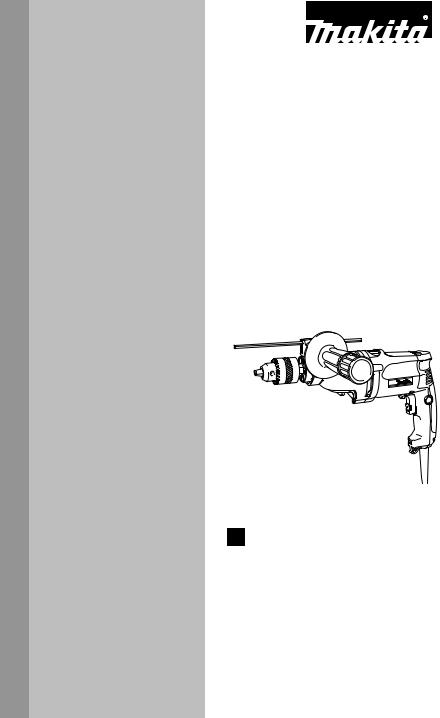
INSTRUCTION MANUAL
MANUEL D'INSTRUCTION MANUAL DE INSTRUCCIONES
2-Speed Hammer Drill
Perceuse à Percussion 2-Vitesses 2 Velocidad Taladro de percusión
HP2050
HP2050F
HP2051F
002989
DOUBLE INSULATION DOUBLE ISOLATION
DOBLE AISLAMIENTO
 WARNING:
WARNING:
For your personal safety, READ and UNDERSTAND before using. SAVE THESE INSTRUCTIONS FOR FUTURE REFERENCE.
 AVERTISSEMENT:
AVERTISSEMENT:
Pour votre propre sécurité, prière de lire attentivement avant l'utilisation. GARDER CES INSTRUCTIONS POUR RÉFÉRENCE ULTÉRIEURE.
 ADVERTENCIA:
ADVERTENCIA:
Para su seguridad personal, LEA DETENIDAMENTE este manual antes de usar la herramienta.
GUARDE ESTAS INSTRUCCIONES PARA FUTURA REFERENCIA.

ENGLISH
SPECIFICATIONS
|
Model |
HP2050/2050F |
HP2051F |
|||
|
Speed |
High |
Low |
High |
Low |
|
|
|
Concrete |
20 mm (3/4") |
----- |
20 mm (3/4") |
----- |
Capacities |
|
Steel |
8 mm (5/16") |
13 mm (1/2") |
8 mm (5/16") |
13 mm (1/2") |
|
|
Wood |
25 mm (1") |
40 mm (1-9/16") |
25 mm (1") |
40 mm (1-9/16") |
|
No load speed (RPM) |
0 - 2,900/min. |
0 - 1,200/min. |
0 - 2,900/min. |
0 - 1,200/min. |
|
|
Blows per minute |
0 - 58,000 |
0 - 24,000 |
0 - 58,000 |
0 - 24,000 |
|
|
Overall length |
362 mm (14-1/4") |
360 mm (14-1/8") |
|||
|
Net weight |
2.5 kg (5.6 lbs) |
2.5 kg (5.6 lbs) |
|||
•Due to our continuing programme of research and development, the specifications herein are subject to change without notice.
•Specifications may differ from country to country.
•Weight according to EPTA-Procedure 01/2003
USA002-2
GENERAL SAFETY RULES
(For All Tools)
WARNING! Read and understand all instructions.
Failure to follow all instructions listed below, may result in electric shock, fire and/or serious personal injury.
SAVE THESE INSTRUCTIONS.
Work Area
1.Keep your work area clean and well lit.
Cluttered benches and dark areas invite accidents.
2.Do not operate power tools in explosive atmospheres, such as in the presence of flammable liquids, gases or dust. Power tools create sparks which may ignite the dust or fumes.
3.Keep bystanders, children, and visitors away
while operating a power tool. Distractions can cause you to lose control.
Electrical Safety
4.Double insulated tools are equipped with a polarized plug ( one blade is wider than the other.) This plug will fit in a polarized outlet only one way. If the plug does not fit fully in the outlet, reverse the plug. If it still does not fit, contact a qualified electrician to install a polarized outlet. Do not change the plug in any way. Double insulation  eliminates the need for the three wire grounded power cord and grounded power supply system.
eliminates the need for the three wire grounded power cord and grounded power supply system.
6.Do not expose power tools to rain or wet conditions. Water entering a power tool will increase the risk of electric shock.
7.Do not abuse the cord. Never use the cord to carry the tools or pull the plug from an outlet. Keep cord away from heat, oil, sharp edges or moving parts. Replace damaged cords immediately. Damaged cords increase the risk of electric shock.
8.When operating a power tool outside, use an
outdoor extension cord marked "W-A" or "W".
These cords are rated for outdoor use and reduce the risk of electric shock.
Personal Safety
9.Stay alert, watch what you are doing and use common sense when operating a power tool. Do not use tool while tired or under the influence of drugs, alcohol, or medication. A moment of inattention while operating power tools may result in serious personal injury.
10.Dress properly. Do not wear loose clothing or jewelry. Contain long hair. Keep your hair, clothing, and gloves away from moving parts.
Loose clothes, jewelry, or long hair can be caught in moving parts.
11.Avoid accidental starting. Be sure switch is off before plugging in. Carrying tools with your finger on the switch or plugging in tools that have the switch on invites accidents.
12.Remove adjusting keys or wrenches before turning the tool on. A wrench or a key that is left attached to a rotating part of the tool may result in personal injury.
5.Avoid body contact with grounded surfaces 13. Do not overreach. Keep proper footing and
such as pipes, radiators, ranges and refrigerators. There is an increased risk of electric shock if your body is grounded.
balance at all times. Proper footing and balance enables better control of the tool in unexpected situations.
2

14.Use safety equipment. Always wear eye protection. Dust mask, non-skid safety shoes, hard hat, or hearing protection must be used for
appropriate conditions. Ordinary eye or sun glasses are NOT eye protection.
Tool Use and Care
15.Use clamps or other practical way to secure and support the workpiece to a stable platform.
Holding the work by hand or against your body is unstable and may lead to loss of control.
16.Do not force tool. Use the correct tool for your application. The correct tool will do the job better and safer at the rate for which it is designed.
17.Do not use tool if switch does not turn it on or off. Any tool that cannot be controlled with the switch is dangerous and must be repaired.
18.Disconnect the plug from the power source before making any adjustments, changing accessories, or storing the tool. Such preventive safety measures reduce the risk of starting the tool accidentally.
19.Store idle tools out of reach of children and other untrained persons. Tools are dangerous in the hands of untrained users.
20.Maintain tools with care. Keep cutting tools sharp and clean. Properly maintained tools with sharp cutting edges are less likely to bind and are easier to control.
21.Check for misalignment or binding of moving parts, breakage of parts, and any other condition that may affect the tool’s operation. If damaged, have the tool serviced before using. Many accidents are caused by poorly maintained tools.
22.Use only accessories that are recommended by the manufacturer for your model.
Accessories that may be suitable for one tool, may become hazardous when used on another
tool.
SERVICE
23.Tool service must be performed only by qualified repair personnel. Service or maintenance performed by unqualified personnel could result in a risk of injury.
24.When servicing a tool, use only identical replacement parts. Follow instructions in the Maintenance section of this manual. Use of
unauthorized parts or failure to follow Maintenance instructions may create a risk of electric shock or injury.
USE PROPER EXTENSION CORD. Make sure your extension cord is in good condition. When using an extension cord, be sure to use one heavy enough to carry the current your product will draw. An undersized cord will cause a drop in line voltage resulting in loss of power and overheating. Table 1 shows the correct size to use depending on cord length and nameplate ampere rating. If in doubt, use the next heavier gage. The smaller the gage number, the heavier the cord.
Table 1: Minimum gage for cord
Ampere Rating |
Volts |
|
Total length of cord in feet |
|
||||
|
|
|
|
|
|
|
||
|
|
120 V |
25 ft. |
|
50 ft. |
100 ft. |
|
150 ft. |
More Than |
Not More Than |
|
|
|
AWG |
|
|
|
|
|
|
|
|
|
|
|
|
0 |
6 |
|
18 |
|
16 |
16 |
|
14 |
6 |
10 |
|
18 |
|
16 |
14 |
|
12 |
10 |
12 |
|
16 |
|
16 |
14 |
|
12 |
12 |
16 |
|
14 |
|
12 |
Not Recommended |
||
000173
USB002-2
SPECIFIC SAFETY RULES
DO NOT let comfort or familiarity with product (gained from repeated use) replace strict adherence to hammer drill safety rules. If you use this tool unsafely or incorrectly, you can suffer serious personal injury.
1.Hold tool by insulated gripping surfaces when performing an operation where the cutting tool may contact hidden wiring or its own cord.
Contact with a "live" wire will make exposed metal parts of the tool "live" and shock the operator.
2.Always be sure you have a firm footing.
Be sure no one is below when using the tool in high locations.
3
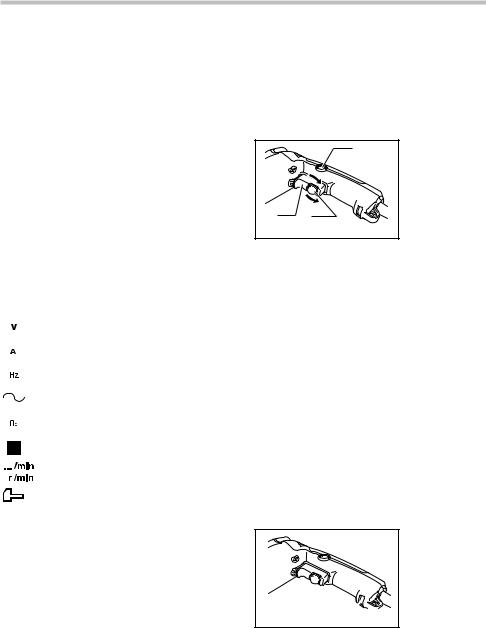
3.Hold the tool firmly with both hands. Always use the side grip.
4.Keep hands away from rotating parts.
5.Do not leave the tool running. Operate the tool only when hand-held.
6.Do not touch the bit or the workpiece immediately after operation; they may be extremely hot and could burn your skin.
7.Some material contains chemicals which may be toxic. Take caution to prevent dust inhalation and skin contact. Follow material supplier safety data.
SAVE THESE INSTRUCTIONS.
 WARNING:
WARNING:
MISUSE or failure to follow the safety rules stated in this instruction manual may cause serious personal injury.
USD202-2
Symbols
The followings show the symbols used for tool.
volts
amperes
hertz
alternating current
no load speed
Class II Construction
revolutions or reciprocation per minute
number of blow
FUNCTIONAL DESCRIPTION
 CAUTION:
CAUTION:
•Always be sure that the tool is switched off and unplugged before adjusting or checking function on the tool.
Switch action
|
1 |
|
4 |
3 |
5 |
2 |
|
002990 |
|
1.Lock button
2.Speed control screw
3.Switch trigger
4.Higher
5.Lower
 CAUTION:
CAUTION:
•Before plugging in the tool, always check to see that the switch trigger actuates properly and returns to the "OFF" position when released.
•Switch can be locked in "ON" position for ease of operator comfort during extended use. Apply caution when locking tool in "ON" position and maintain firm grasp on tool.
To start the tool, simply pull the switch trigger. Tool speed is increased by increasing pressure on the switch trigger. Release the switch trigger to stop.
For continuous operation, pull the switch trigger and then push in the lock button.
To stop the tool from the locked position, pull the switch trigger fully, then release it.
A speed control screw is provided so that maximum tool speed can be limited (variable). Turn the speed control screw clockwise for higher speed, and counterclockwise for lower speed.
Lighting up the lamps
For Model HP2050F, HP2051F
1. Lamp
1

002689
 CAUTION:
CAUTION:
•Do not look in the light or see the source of light directly.
4
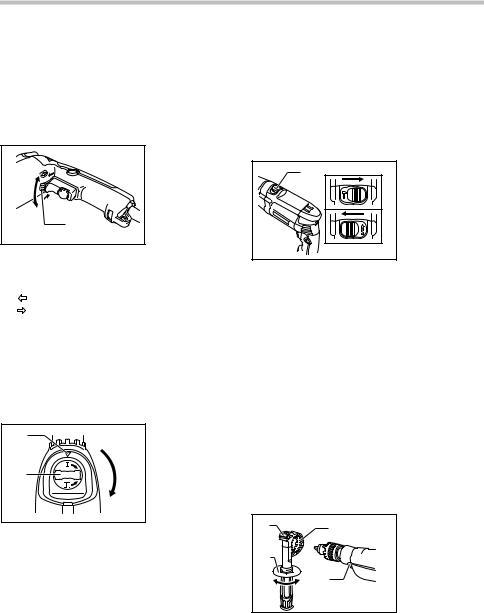
To turn on the lamp, pull the trigger. Release the trigger to turn it off.
NOTE:
•Use a dry cloth to wipe the dirt off the lens of lamp. Be careful not to scratch the lens of lamp, or it may lower the illumination.
Reversing switch action
1. Reversing
switch lever
A
B
1
002991
This tool has a reversing switch to change the direction
of |
rotation. Move the reversing switch lever |
to |
the |
position (A side) for clockwise rotation |
or |
the |
position (B side) for counterclockwise rotation. |
|
 CAUTION:
CAUTION:
•Always check the direction of rotation before operation.
•Use the reversing switch only after the tool comes to a complete stop. Changing the direction of rotation before the tool stops may damage the tool.
Speed change
1 |
1. Arrow |
|
2. Speed change |
||
|
||
|
knob |
|
2 |
|
002691
Two speed ranges can be preselected with the speed change knob.
To change the speed, turn the speed change knob so that the arrow on the tool body points toward the "I" position on the knob for low speed or "II" position for high speed.
If it is hard to turn the knob, first turn the chuck slightly in either direction and then turn the knob again.
 CAUTION:
CAUTION:
•Use the speed change knob only after the tool comes to a complete stop. Changing the tool speed before the tool stops may damage the tool.
•Always set the speed change knob to the correct position. If you operate the tool with the speed change knob positioned halfway between the "I" and "II" position, the tool may be damaged.
Selecting the action mode
1 |
002692 |
1.Action mode changing lever
This tool has an action mode change lever. For rotation with hammering, slide the action mode change lever to the right (  symbol). For rotation only, slide the action mode change lever to the left (
symbol). For rotation only, slide the action mode change lever to the left (  symbol).
symbol).
 CAUTION:
CAUTION:
•Always slide the action mode change lever all the way to your desired mode position. If you operate the tool with the lever positioned halfway between the mode symbols, the tool may be damaged.
ASSEMBLY
 CAUTION:
CAUTION:
•Always be sure that the tool is switched off and unplugged before carrying out any work on the tool.
Installing side grip (auxiliary handle)
1 |
|
3 |
1. Grip base |
|
|
2. |
Side grip |
||
|
|
|
||
|
|
|
|
(auxiliary |
2 |
|
|
|
handle) |
|
|
3. Teeth |
||
|
|
|
||
|
4 |
|
4. |
Protrusions |
|
|
|
|
|
002693
5
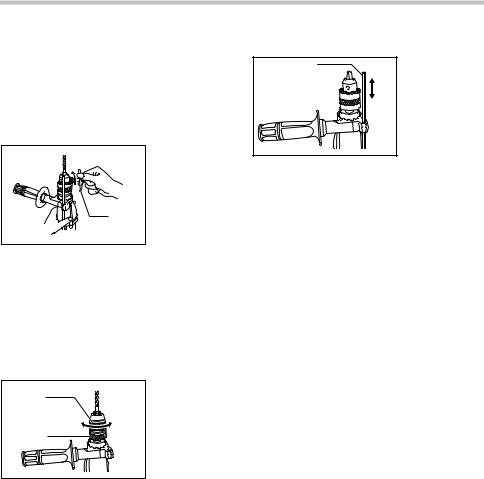
Always use the side grip to ensure operating safety. Install the side grip so that the teeth on the grip fit in between the protrusions on the tool barrel.
Then tighten the grip by turning clockwise at the desired position. It may be swung 360° so as to be secured at any position.
Installing or removing drill bit
For Model HP2050, HP2050F
1. Chuck key
1
002694
To install the bit, place it in the chuck as far as it will go. Tighten the chuck by hand. Place the chuck key in each of the three holes and tighten clockwise. Be sure to tighten all three chuck holes evenly.
To remove the bit, turn the chuck key counterclockwise in just one hole, then loosen the chuck by hand.
After using the chuck key, be sure to return to the original position.
For Model HP2051F
1 |
1. |
Sleeve |
2. |
Ring |
|
2 |
|
|
002695
Hold the ring and turn the sleeve counterclockwise to open the chuck jaws. Place the bit in the chuck as far as it will go. Hold the ring firmly and turn the sleeve clockwise to tighten the chuck.
To remove the bit, hold the ring and turn the sleeve counterclockwise.
Depth gauge
1 |
1. Depth gauge |
002696
The depth gauge is convenient for drilling holes of uniform depth. Loosen the side grip and insert the depth gauge into the hole in the side grip. Adjust the depth gauge to the desired depth and tighten the side grip.
NOTE:
•The depth gauge cannot be used at the position where the depth gauge strikes against the tool body.
OPERATION
Hammer drilling operation
 CAUTION:
CAUTION:
•There is a tremendous and sudden twisting force exerted on the tool/bit at the time of hole break-through, when the hole becomes clogged with chips and particles, or when striking reinforcing rods embedded in the concrete. Always use the side grip (auxiliary handle) and firmly hold the tool by both side grip and switch handle during
operations. Failure to do so may result in the loss of control of the tool and potentially severe injury.
When drilling in concrete, granite, tile, etc., move the action mode changing lever to the position of  symbol to use "rotation with hammering" action.
symbol to use "rotation with hammering" action.
Be sure to use a tungsten-carbide tipped bit.
Position the bit at the desired location for the hole, then pull the switch trigger. Do not force the tool. Light pressure gives best results. Keep the tool in position and prevent it from slipping away from the hole.
Do not apply more pressure when the hole becomes clogged with chips or particles. Instead, run the tool at an idle, then remove the bit partially from the hole. By repeating this several times, the hole will be cleaned out and normal drilling may be resumed.
6
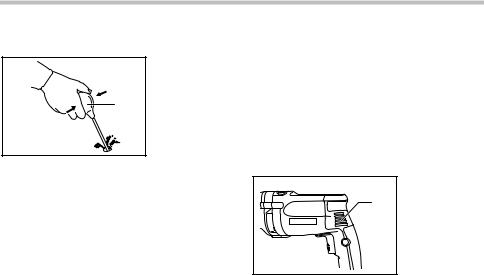
Blow-out bulb (optional accessory)
1. Blow-out bulb
1
002449
After drilling the hole, use the blow-out bulb to clean the dust out of the hole.
Drilling operation
When drilling in wood, metal or plastic materials, move the action mode changing lever to the position of  symbol to use "rotation only" action.
symbol to use "rotation only" action.
Drilling in wood
When drilling in wood, the best results are obtained with wood drills equipped with a guide screw. The guide screw makes drilling easier by pulling the bit into the workpiece.
Drilling in metal
To prevent the bit from slipping when starting a hole, make an indentation with a center-punch and hammer at the point to be drilled. Place the point of the bit in the indentation and start drilling.
Use a cutting lubricant when drilling metals. The exceptions are iron and brass which should be drilled dry.
 CAUTION:
CAUTION:
•Pressing excessively on the tool will not speed up the drilling. In fact, this excessive pressure will only serve to damage the tip of your bit, decrease the tool performance and shorten the service life of the tool.
•There is a tremendous force exerted on the tool/bit at the time of hole break through. Hold the tool firmly and exert care when the bit begins to break through the workpiece.
•A stuck bit can be removed simply by setting the reversing switch to reverse rotation in order to back out. However, the tool may back out abruptly if you do not hold it firmly.
•Always secure small workpieces in a vise or similar hold-down device.
MAINTENANCE
 CAUTION:
CAUTION:
•Always be sure that the tool is switched off and unplugged before attempting to perform inspection or maintenance.
Cleaning vent holes
The tool and its air vents have to be kept clean. Regularly clean the tool's air vents or whenever the vents start to become obstructed.
1. Vent holes
1
002697
To maintain product SAFETY and RELIABILITY, repairs, carbon brush inspection and replacement, any other maintenance or adjustment should be performed by Makita Authorized or Factory Service Centers, always using Makita replacement parts.
ACCESSORIES
 CAUTION:
CAUTION:
•These accessories or attachments are recommended for use with your Makita tool specified in this manual. The use of any other accessories or attachments might present a risk of
injury to persons. Only use accessory or attachment for its stated purpose.
If you need any assistance for more details regarding these accessories, ask your local Makita Service Center.
•Drill bits
•Hammer drill bits
•Hole saws
•Blow-out bulb
•Safety goggles
•Chuck key
•Grip assembly
•Depth gauge
•Plastic carrying case
7

MAKITA LIMITED ONE YEAR WARRANTY
Warranty Policy
Every Makita tool is thoroughly inspected and tested before leaving the factory. It is warranted to be free of defects from workmanship and materials for the period of ONE YEAR from the date of original purchase. Should any trouble develop during this one year period, return the COMPLETE tool, freight prepaid, to one of Makita’s Factory or Authorized Service Centers. If inspection shows the trouble is caused by defective workmanship or material, Makita will repair (or at our option, replace) without charge.
This Warranty does not apply where:
repairs have been made or attempted by others:
repairs are required because of normal wear and tear:
the tool has been abused, misused or improperly maintained:
alterations have been made to the tool.
IN NO EVENT SHALL MAKITA BE LIABLE FOR ANY INDIRECT, INCIDENTAL OR CONSEQUENTIAL DAMAGES FROM THE SALE OR USE OF THE PRODUCT. THIS DISCLAIMER APPLIES BOTH DURING AND AFTER THE TERM OF THIS WARRANTY.
MAKITA DISCLAIMS LIABILITY FOR ANY IMPLIED WARRANTIES, INCLUDING IMPLIED WARRANTIES OF "MERCHANTABILITY" AND "FITNESS FOR A SPECIFIC PURPOSE," AFTER THE ONE YEAR TERM OF THIS WARRANTY.
This Warranty gives you specific legal rights, and you may also have other rights which vary from state to state. Some states do not allow the exclusion or limitation of incidental or consequential damages, so the above limitation or exclusion may not apply to you. Some states do not allow limitation on how long an implied warranty lasts, so the above limitation may not apply to you.
EN0006-1
8

FRANÇAIS
SPÉCIFICATIONS
|
Modèle |
HP2050/2050F |
HP2051F |
|||
|
Vitesse |
Grande |
Bas |
Grande |
Bas |
|
|
|
Béton |
20 mm (3/4") |
----- |
20 mm (3/4") |
----- |
Capacités |
|
Acier |
8 mm (5/16") |
13 mm (1/2") |
8 mm (5/16") |
13 mm (1/2") |
|
|
Bois |
25 mm (1") |
40 mm (1-9/16") |
25 mm (1") |
40 mm (1-9/16") |
|
Vitesse à vide (T/MIN) |
0 - 2 900/min. |
0 - 1 200/min. |
0 - 2 900/min. |
0 - 1 200/min. |
|
Nombre de frappes par minute |
0 - 58 000 |
0 - 24 000 |
0 - 58 000 |
0 - 24 000 |
||
|
Longueur totale |
362 mm (14-1/4") |
360 mm (14-1/8") |
|||
|
Poids net |
2,5 kg (5,6 lbs) |
2,5 kg (5,6 lbs) |
|||
•Étant donné l'évolution constante de notre programme de recherche et de développement, les spécifications contenues dans ce manuel sont sujettes à modification sans préavis.
•Les spécifications peuvent varier suivant les pays.
• Poids conforme à la procédure EPTA du 01/2003
USA002-2
Règles de sécurité générales
(POUR TOUS LES OUTILS)
MISE EN GARDE ! Assurez-vous d'avoir lu et compris toutes les instructions. Il y a risque de choc électrique, d'incendie et/ou de blessure grave si les instructions ci-dessous ne sont pas respectées.
CONSERVEZ CE MODE
D'EMPLOI.
Zone de travail
1.Maintenez votre aire de travail propre et bien éclairée. Les établis encombrés et les aires de travail sombres ouvrent la porte aux accidents.
2.N'utilisez pas les outils électriques dans les atmosphères explosives, par exemple en présence de liquides, gaz ou poussières inflammables. Les outils électriques produisent des étincelles au contact desquelles la poussière ou les vapeurs peuvent s'enflammer.
3.Tenez à distance les curieux, les enfants et les visiteurs pendant que vous travaillez avec un
outil électrique. Ils pourraient vous distraire et vous faire perdre la maîtrise de l'outil.
Sécurité en matière d'électricité
4.Les outils à double isolation sont équipés d'une fiche polarisée (une des lames est plus large que l'autre), qui ne peut se brancher que d'une seule façon dans une prise polarisée. Si la fiche n'entre pas parfaitement dans la prise, inversez sa position ; si elle n'entre toujours pas bien, demandez à un électricien qualifié d'installer une prise de courant polarisée. Ne
modifiez pas la fiche de l'outil. La double isolation  élimine le besoin d'un cordon d'alimentation à trois fils avec mise à la terre ainsi que d'une prise de courant mise à la terre.
élimine le besoin d'un cordon d'alimentation à trois fils avec mise à la terre ainsi que d'une prise de courant mise à la terre.
5.Évitez tout contact corporel avec des surfaces mises à la terre (tuyauterie, radiateurs, cuisinières, réfrigérateurs, etc.). Le risque de choc électrique est plus grand si votre corps est en contact avec la terre.
6.N'exposez pas les outils électriques à la pluie ou à l'eau. La présence d'eau dans un outil électrique augmente le risque de choc électrique.
7.Ne maltraitez pas le cordon. Ne transportez pas l'outil par son cordon et ne débranchez pas la fiche en tirant sur le cordon. Gardez le cordon à l'écart de la chaleur, de l'huile, des bords tranchants et des pièces en mouvement. Remplacez immédiatement un cordon endommagé. Un cordon endommagé augmente le risque de choc électrique.
8.Lorsque vous utilisez un outil électrique à l'extérieur, employez un prolongateur pour
l'extérieur marqué "W-A" ou "W". Ces cordons sont faits pour être utilisés à l'extérieur et réduisent le risque de choc électrique.
Sécurité personnelle
9.Restez alerte, attentif à vos gestes, et faites preuve de bon sens lorsque vous utilisez un outil électrique. Évitez d'utiliser l'outil lorsque vous êtes fatigué ou sous l'influence de drogues, d'alcool ou de médicaments. Tout moment d'inattention pendant l'utilisation d'un outil électrique comporte un risque de blessure grave.
9
